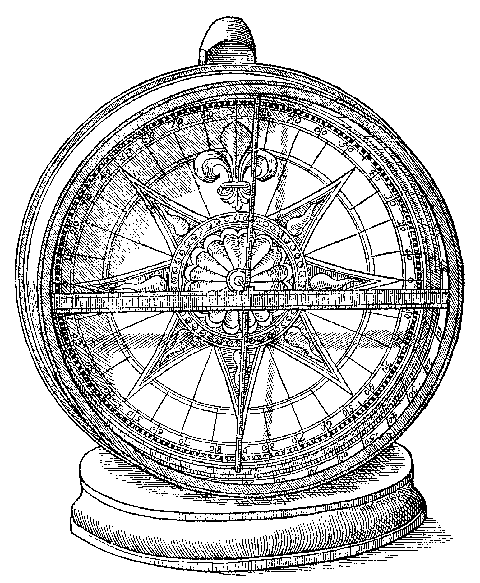Geomagnetic Field Observations From the Past to the Present
|
Magnus magnet ipse est globus terrestris A great magnet itself is globe Earth William Gilbert in de magnete London, 1600 |
||
|
6th century B.C Greek philosopher Thales confirms knowledge of magnetic properties
Petrus Peregrinus writes his Epistola de Magnete in 1269
In the year 1544 Georg Hartmann discovers magnetic inclination William Gilbert publishes his treatise on magnetism stating that Earth behaved like a large spherical magnet in 1600 Year 1634. Astronomer Henry Gellibrand discovers that magnetic inclination changes over time |
Dipcircle design by W. Gilbert 
|
In the year 1702 Edmund Halley publishes the first declination chart after a long sea voyage Alexander von Humbolt discovers magnetization of rocks and and field strength variations at the end of the 18th century
May 31, 1831. James Clark Ross is first to arrive at the Magnetic North Pole 1838 Carl Friedrich Gauss mathematically configures a field strength chart for his Allgemeine Theorie des Erdmagnetismus
Samuel Heinrich Schwabe publishes his decade-long sunspot observations in 1843
Bernard Brunhes in 1906 recognizes reversed polarity magnetization in volcanic rocks 1924 Geologist Alfred Wegner proposes continental drift theory
|
|
The powers of a magnet called a lodestone were known to early civilizations and its ‘attractive spirit’ acclaimed by Homer, Thales and Aristoleles. Its function as a compass has been documented for over 2000 years and the Chinese knew of the magnetic declination at least since 720 A.D. (Merrill & McElhinney). But in Europe, the dipole nature of magnets was not recognized until late in the 13th century when Peregrinus of Picardy described the forces as exhibiting polarity. Georg Hartmann, a Nuremberg preacher, and Robert Norman, a navigational instrument maker, discovered magnetic inclination. William Gilbert, physician to Queen Elizabeth I, verified the observations and, conducting experiments with a lodestone, he discovered changes in inclination for different locations (Chapman, 1964; Merrill & McElhinney). In his illustration from de magnete, a suspended non-magnetic needle inside a water-filled goblet displays a dip of about 70 degrees, the inclination of London at the time. In his treatise, Gilbert then compared Earth to a great spherical magnet and designed the first applicable dip-circle (Chapman, 1964). |
In 1838, German mathematician Carl Friedrich Gauss developed coefficients for the configuration of magnetic field vector values, and he predicted the precise locations of the geomagnetic poles (Merrill & McElhinney). The calculations were instrumental in determining in retrospect that James Clark Ross had first reached the true Magnetic North Pole in 1831. Gauss' work was also of great importance for consecutive deductions about Earth's magnetic field. But the reasons for the apparent polar wanderings remained unsolved. In addition, paleomagnetic evidence in rocks for a reversed polarity, discovered by Bernard Brunhes in 1906, presented an even greater mystery. When with the detection of the sunspot cycles in 1843 by Samuel Heinrich Schwabe of Dessau a connection was established between surface activity on the sun and temporary variations of the magnetic field, this and the emerging concept of electricity essentially became the keys to modern geomagnetism theory. Research diversified following the discovery of atoms, and unified results of all disciplines led to the proposal of the existence of plasma in the ionosphere and the presence of a magnetosphere. Today we know that the magnetic field undergoes stark changes during a magnetic storm and that these storms not only compromise navigational and communi- |
cational equipment, but also substantially weaken the field. We also know that the poles are not fixed, that they wander due to changes in core conductivity and that the entire field can flip after prolonged weakening. Magnetization in rocks shows this happened many times over the course of Earth’s history and this compelling fact was the most supportive evidence that led to the acceptance of tectonic plate theory in the 1960s. In the picture below, the white lines represent periods of reversed polarity and the spacing of the black and white lines represent the duration of each magnetic field event which can be read off the timeline to the right.
For more on reversals click here |
 source: http://www.phy6.org/earthmag/upto1600.htm
source: http://www.phy6.org/earthmag/upto1600.htm 